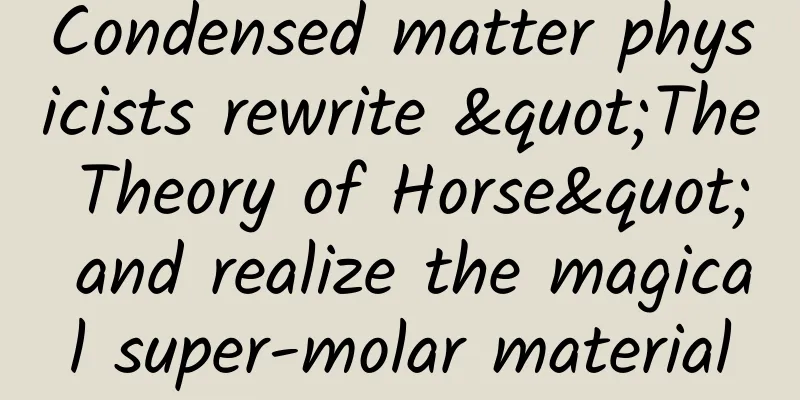Oppenheimer swept the Oscars! He is not only the father of the atomic bomb

|
Oppenheimer, the "father of the atomic bomb", is a controversial celebrity. The movie "Oppenheimer" has made him, who has been dead for 56 years, one of the hot topics in the world's public opinion. Due to his complicated experience and personality, most people have overlooked his important contributions in the field of physics. This article introduces several representative and important achievements of Oppenheimer to let people have a deeper understanding of his contributions to physics and astronomy. Written by | Wang Shanqin J. Robert Oppenheimer (1904-1967) is a controversial celebrity. He gained great fame as the "Father of the Atomic Bomb" because he led a group of scientists and engineers to build the world's first atomic bomb and successfully explode it ("Manhattan Project"). He was suppressed by the military and government because he opposed the United States' production of hydrogen bombs after the end of World War II, and was censored because of his close relationship with left-wing figures before, becoming a tragic figure. Oppenheimer's ID card photo during his time leading the Manhattan Project. His ID number was K6. Image source: Los Alamos National Laboratory He had close contacts and collaborations with many of his scientific colleagues, but was criticized on a moral level for interfering in the marriages of at least two of his collaborators. Some people thought he was a genius, some thought he was pretentious, and some thought he was a playboy who loved to flirt with women. Oppenheimer's complex personality and experience have caused most people to ignore his identity as a physicist, and therefore ignore his important contributions to physics and astronomy. This article introduces several representative and important achievements of Oppenheimer to allow people to have a deeper understanding of his contributions to physics and astronomy. Early learning experience Oppenheimer was born into a Jewish family in New York City on April 22, 1904. His mother, Ella Oppenheimer (1869-1931), was a painter; his father was Julius Seligmann Oppenheimer (1871-1937), a wealthy textile importer. Oppenheimer's father and mother. Image source: Public copyright In 1921, Oppenheimer graduated from high school, but took a year off because of colitis. In 1922, Oppenheimer entered Harvard University, majoring in chemistry. In 1925, he graduated from Harvard University with a bachelor's degree with honors. Oppenheimer's talent may have been partly genetic. Although his father did not go to college, he was very capable. His younger brother Frank Oppenheimer (1912-1985) later became a physicist, studied nuclear physics, and participated in uranium enrichment work in the Manhattan Project. In 1924, Oppenheimer was admitted to Cambridge University. He originally wanted to follow the famous experimental physicist Ernest Rutherford (1871-1937), but his university tutor had said in a letter of recommendation that he was strong in theory but weak in experiment. Rutherford was naturally not interested in him after reading this "reverse letter of recommendation". However, he still went to Cambridge University after graduating from Harvard University. After some bargaining, Rutherford's former mentor, Joseph John Thomson (1856-1940), accepted him on the condition that Oppenheimer complete a basic laboratory course. This requirement almost sent Oppenheimer away. He suffered from poor experimental skills and homesickness, and his relationship with the instructor of this course, Patrick Blackett (1897-1974), also deteriorated sharply. Oppenheimer once placed a poisoned apple on Blackett's desk in an attempt to poison him, but Blackett didn't eat it. In the movie Oppenheimer, Oppenheimer, who regretted his decision, ran into the laboratory and happened to see Niels Bohr (1885-1962), who was visiting the laboratory, picking up a poisoned apple and trying to eat it. Oppenheimer snatched it away and threw it into the trash can, saying that the apple was eaten by insects. This plot should be fictional, because such a coincidence probably only happens in movies, TV shows and novels. In fact, Oppenheimer almost went to jail for attempting to poison his mentor. Oppenheimer's parents asked Cambridge University not to press criminal charges or expel him. Oppenheimer was eventually sentenced to probation and had to meet regularly with a psychiatrist in London for psychological treatment. If he had actually taken the poisoned apple and thrown it away, no one would have known about it and he would not have almost gone to jail. Blackett, who escaped the disaster, won the 1948 Nobel Prize in Physics for his achievements in experimental physics. Molecular Continuum, Molecular Dynamics and Chemical Bonds In 1926, after a year of suffering in the laboratory of Cambridge University, Oppenheimer went to the University of Göttingen, one of the world's physics centers at the time, to study under the master of quantum mechanics Max Born (1882-1970). A year earlier, Werner Heisenberg (1901-1976) established the matrix form of quantum mechanics, and quantum mechanics was born; Born and Pascual Jordan (1902-1980) soon perfected this epoch-making work with Heisenberg in the same year. Oppenheimer had a great time at the University of Göttingen. In 1926, Oppenheimer completed the quantum theory of the molecular continuum. He obtained a method to calculate the probability of electron transitions, and used it to calculate the photoelectric effect of hydrogen and X-rays, and obtained the absorption coefficient of the K edge. His calculations were consistent with the observations of the X-ray absorption of the sun, but inconsistent with the observations of the X-ray absorption of helium in the laboratory. Many years later, it was confirmed that the sun was mainly composed of hydrogen, and his calculations were correct. In March 1927, the 23-year-old Oppenheimer passed his doctoral thesis defense and received his doctorate degree, less than two years after he graduated from college and only one year after he started his doctoral studies. The chairman of the defense committee was James Franck (1882-1964), who was famous for conducting the Franck-Hertz experiment with Gustav Hertz (1887-1975), which proved the energy level theory of hydrogen atoms proposed by Bohr. The two won the Nobel Prize in Physics in 1925. Hertz here was the son of the younger brother of Heinrich Hertz (1857-1894), who verified the electromagnetic wave theory. After the defense, Frank said, "I'm glad the defense is over. He was the one asking me questions." (Normally, the defense committee members ask students questions to test their true abilities.) In 1927, Oppenheimer and Born published an important paper on molecular dynamics. (This paper was accepted by the journal in August of that year, so it was submitted after he graduated with his doctorate. But Oppenheimer should have collaborated with Born on this research before he graduated with his doctorate.) This paper separates the motion of the nucleus from the motion of the electrons in the molecule, ignoring the motion of the nucleus, so that the dynamic properties of the molecule can be calculated using quantum mechanics. This approximate method is called the "Born-Oppenheimer approximation", which is one of the important foundations of quantum chemistry and molecular physics. In the movie "Oppenheimer", when Oppenheimer and Heisenberg first met, the latter praised the former's work on molecules, referring to the Born-Oppenheimer approximation. Although Heisenberg was only three years older than Oppenheimer, he had become one of the leading figures in the field of physics at the time because of his previous creation of quantum mechanics. In comparison, Oppenheimer's qualifications at the time were still relatively young. It is reasonable for Heisenberg to praise Oppenheimer in the tone of an academic elder. While in Europe, Oppenheimer published more than a dozen papers, and with the high quality of these papers, he easily won the United States National Research Council Fellowship offered by the California Institute of Technology (Caltech) in September 1927. While at Caltech, Oppenheimer developed a close friendship with Linus Pauling (1901-1994). They collaborated on studying the nature of chemical bonds, with Oppenheimer performing mathematical calculations and Pauling interpreting the results. However, their friendship soon ended when Oppenheimer began dating Pauling's wife. Pauling won the Nobel Prize in Chemistry in 1954 and the Peace Prize in 1962, becoming one of the first double Nobel laureates. In the fall of 1928, Oppenheimer visited the University of Leiden in the Netherlands and gave a report in Dutch, which he had just learned. During this period, he was nicknamed Opje, which his students later translated into English as Oppie. In the movie "Oppenheimer", the nickname "Oppie" used by friends and the collective chanting of "Oppie, Oppie, Oppie..." by students originated from this. Positron theory After returning to China, Oppenheimer was hired as an associate professor in the Department of Physics at the University of California, Berkeley (UCB), and was invited by Caltech to work part-time. In 1928, Paul Dirac (1902-1984) combined quantum mechanics with relativity and established relativistic quantum mechanics. Dirac discovered that this equation would lead to a negative energy solution in addition to a positive energy solution describing an electron, which he believed represented a proton. In 1930, Oppenheimer published a paper titled "Note on the theory of the interaction of field and matter" in which he objected to Dirac's view. He believed that the mass of the particle corresponding to the negative energy solution should be equal to that of the electron, and the mass of the proton is much larger than that of the electron, so the negative energy solution cannot be a proton; if the negative energy solution is a proton, then the hydrogen atom will quickly self-destruct. The famous mathematical physicist Hermann Weyl (1885-1955) also proposed in 1931 that the mass of the particle corresponding to the negative energy solution should be equal to that of the electron. Driven by Oppenheimer and Weyl, Dirac proposed in 1931 that the negative energy solution represents an undiscovered particle with the same mass as the electron and an opposite charge, that is, positive. This is the positron. In fact, Oppenheimer's 1930 paper essentially predicted the existence of the positron. In 1936, Carl David Anderson (1905-1991) discovered positrons in cosmic rays, which was the first time that antiparticles were discovered by humans. For this, Anderson won the 1936 Nobel Prize in Physics. Lamb shift and quantum electrodynamics According to the Dirac equation, the two energy levels of the hydrogen atom, 2S1/2 and 2P1/2, have the same energy ("degenerate"). In 1931, Oppenheimer and his student Harvey Hall published a paper titled "Relativistic Theory of the Photoelectric Effect", pointing out that the two energy levels actually have different energies. Hall received his doctorate in 1931 and was the first doctoral student to graduate under Oppenheimer's name. In 1947, another doctoral student of Oppenheimer, Willis Lamb (1913-2008, who received his doctorate under Oppenheimer's guidance in 1938) and Robert Retherford (1912-1981, Lamb's doctoral student, not Rutherford mentioned above) used microwave technology to experimentally measure the energy difference between the two energy levels, and this difference was therefore called the "Lamb shift". Lamb won the 1955 Nobel Prize in Physics for measuring the Lamb shift. In the same year that the Lamb shift was discovered, Hans Bethe (1906-2005) first explained the mechanism of the Lamb shift, laying the foundation for the development of quantum electrodynamics (QED). Bethe had a deep foundation in nuclear physics; he conducted pioneering research on nuclear reactions inside stars, became an authority in the field of nuclear astrophysics, and was awarded the 1967 Nobel Prize in Physics. Bethe also joined the Manhattan Project during World War II and served as the head of the theoretical group. He played a decisive role in calculating the "critical mass" of the atomic bomb and designing the "implosion method". In the movie "Oppenheimer", Bethe played a very important role. The fragments surrounding the core that often appear in the movie are what the implosion method needs. (After the explosion of these fragments, extremely uniform pressure toward the center is generated. The strong compression reduces the critical mass of the core of the radioactive material to below the mass of the core, so that a chain reaction can be started and the explosion is successful.) Bette. Image credit: Los Alamos National Laboratory Julian Schwinger (1918-1994), who later became one of the masters of QED, also had some contact with Oppenheimer. After receiving his doctorate at the age of 21, he worked as Oppenheimer's postdoctoral fellow at UCB from 1939 to 1941, and won the 1965 Nobel Prize in Physics for his contributions to the field of QED. During his time at UCB, he may have been influenced by Oppenheimer. It is said that Oppenheimer liked to sit down and ask all kinds of questions to his postdoctoral or doctoral students when they were his teaching assistants. When Schwinger was also his teaching assistant, Oppenheimer still did this; however, Schwinger quickly helped Oppenheimer get rid of this habit with his quick and perfect answers (it is unknown whether Oppenheimer resumed this habit after Schwinger left). Schwinger was a favorite student of Rabi (Isidor Rabi, 1898-1988), who was a good friend of Oppenheimer and had an important role in the movie "Oppenheimer". Oppenheimer-Phillips process During his time at UCB, Oppenheimer had a close relationship with the master of experimental physics, Ernest Lawrence (1901-1958), who also played a major role in the film Oppenheimer. Lawrence invented the world's first cyclotron and established a radiation laboratory at UCB, which later became Lawrence Berkeley National Laboratory (LBNL). Oppenheimer provided theoretical explanations for the experimental data obtained by Lawrence's team. LBNL's city commuter bus. Image source: Photographed by the author in downtown Berkeley In 1935, Edwin McMillan (1907-1991), Lawrence and Robert Thornton used a cyclotron to accelerate a beam of deuterium nuclei and bombarded a target nucleus. A deuterium nucleus is composed of a proton and a neutron. When the deuterium nucleus bombards the target nucleus, the protons in it are relatively far away due to the repulsion of the protons in the target nucleus, causing the neutrons to point to the target. When the deuterium nucleus has a high speed, the neutrons in it will fuse with the heavier target nucleus, and the remaining protons will escape. MacMillan and others found that when the deuteron energy was low or the target nucleus was light, the results were very consistent with Gamow's (George Gamow, 1904-1968) theory; when the deuteron energy was high or the target nucleus was heavy, the nuclear interaction ability was lower than the prediction of Gamow's theory. (MacMillan later participated in the Manhattan Project and won the 1951 Nobel Prize in Chemistry for his important contributions to nuclear physics and chemistry. His undergraduate mentor was Pauling.) McMillan (left) and Lawrence (right). Image source: ENERGY.GOV In 1935, Oppenheimer and one of his first doctoral students, Melba Phillips (1907-2004, received her doctorate in 1933), published a paper titled "Note on the transmutation function for deuterons", proposing a theory to explain this result. This theory uses the adiabatic approximation, which assumes that there is no heat loss in the entire system during the collision. This theory was later called the "Oppenheimer-Phillips process", which is an important result in early nuclear physics and is still used today. The ultimate mass of a neutron star In 1936, at the age of 32, Oppenheimer became a full professor. Around this time, he became interested in astrophysics. In 1938, Oppenheimer and his postdoctoral fellow Robert Serber (1909-1997) published "On the Stability of Stellar Neutron Cores", studying the upper limit of the mass of a stable neutron core. In 1939, Oppenheimer and his student George Volkoff (1914-2000) published "On Massive Neutron Cores", which further proved that there is a limit to the mass of neutron stars; beyond this limit, the neutron star will not be able to remain stable, but will shrink unimpeded under the influence of gravity. Because this work was based on the work of Richard Tolman (1881-1948) in 1934 and 1939, this limit is called the "Tolman-Oppenheimer-Volkoff limit", or TOV limit for short. Oppenheimer and Volkov's paper only considered the degeneracy pressure between neutrons, so the TOV limit obtained was only 0.7 solar masses. However, thermal pressure and the strong force between neutrons were ignored. Later studies took these factors into account and obtained a TOV limit between 1.5 and 3 solar masses. The equation of state of extremely dense matter is very complex, so the exact value of the TOV limit has not been determined; now people can be sure that this value can exceed 2 suns, because such a heavy neutron star has been confirmed in observations. Studies on the binary neutron star merger event GW170817 show that the TOV limit of neutron stars can exceed 2.17 suns. Although Oppenheimer and Tolman were good friends and his work was influenced by Tolman's work, he later interfered with Tolman's marriage. He met Tolman's wife, Ruth Tolman (1893-1957), in 1928 (Ruth married Tolman in 1924), and the two became friends first, and then lovers after the end of World War II. Tolman was one of the two mentors during Pauling's doctoral period. It is amazing that he interfered with the marriages of both the master and the apprentice. This relationship did not last long, because Oppenheimer soon left Caltech and became the director of the Institute for Advanced Study (IAS) in Princeton in 1947. In 1948, Tolman died of a heart attack, and Oppenheimer and Ruth continued to have an intermittent relationship. In the movie "Oppenheimer", Oppenheimer refuted the rumor that "Tolman died of a broken heart", which is related to this. Black holes: the continued contraction of massive objects At the end of 1915, Einstein established the theory of general relativity. Soon after, Karl Schwarzschild (1873-1916) obtained the expression of the metric (square of infinitesimal distance) of spacetime near a spherically symmetric stationary celestial body, namely the "Schwarzschild metric". The expression of the Schwarzschild metric becomes infinite in two places, one is where the radius is zero, and the other is where the radius is equal to 2GM/c2. The latter is called the "Schwarzschild radius", "gravitational radius" or the "event horizon" of a spherically symmetric stationary uncharged celestial body. The infinity here can be eliminated by using other coordinates. However, the infinity at the radius of zero cannot be eliminated. If matter is concentrated to this point, its density is infinite, which is the "singularity". (Using the language of space-time geometry that was later developed, it is described as: the geodesic breaks at the singularity.) Schematic diagram of a spherically symmetric stationary uncharged black hole (Schwarzschild black hole). The red dot in the center of the figure is the singularity, where the density is infinite; the boundary is the event horizon, and the distance from the event horizon to the center is the Schwarzschild radius. Source: Sandstorm de In 1939, Albert Einstein (1879-1955) published the paper "On a Stationary System with Spherical Symmetry Consisting of Many Gravitating Masses", using general relativity to prove that black holes cannot be produced. In the same year, Oppenheimer and his doctoral student Hartland Snyder (1913-1962) used general relativity to study the contraction of stars whose mass exceeded the TOV limit based on Oppenheimer and Volkoff's recent paper, and published the paper "On Continuing Gravitational Contraction" on September 1. In this paper, Oppenheimer and Snyder proved that after a star with a large enough mass has exhausted its nuclear fuel, it will continue to shrink under its own gravity and shrink into the Schwarzschild radius. At the Schwarzschild radius and within it, even light cannot escape, so the entire celestial body becomes dark. Such celestial bodies were later called "black holes." This paper by Oppenheimer and Snyder actually first clearly proposed the formation of black holes within the framework of general relativity. Oppenheimer and Snyder also pointed out in detail in this paper: as a star contracts, the gravitational strength on its surface becomes stronger and stronger, the gravitational redshift of starlight becomes more and more significant, and the starlight detected by distant observers becomes redder and gradually becomes long-wave radiation; the time required for distant observers to see the star shrink to the Schwarzschild radius will become infinite, so they will never see this result; however, observers who fall with the shrinking star surface ("co-moving observers") will still feel the passage of time (note by the author: provided that they are not torn apart or killed by tidal forces), and it will only take about 1 day to feel themselves falling to the Schwarzschild radius. These conclusions are still relevant today. An imaginary image of an astronaut passing through a black hole's event horizon (for a spherically symmetric stationary uncharged black hole, the event horizon is the Schwarzschild radius) from the outside in. An observer at a distance cannot see him reach the event horizon, but he himself can see himself approaching the event horizon and passing through it. Image credit: Roen Kelly Oppenheimer and Snyder's paper did not mention Einstein's paper published a few months ago. It is very likely that they had not seen Einstein's paper at the time, and they may not have felt it was appropriate or unnecessary to directly refute Einstein. Einstein and Oppenheimer, 1950. Image credit: US Govt. Defense Threat Reduction Agency The movie "Oppenheimer" shows Oppenheimer and others celebrating the publication of this paper. The movie uses the words of the characters to say that the news of Hitler's war stole the limelight from this paper. In fact, even if this major event had not stolen the limelight, this paper would not have made a splash in the entire academic community at the time, because the physics community at the time was generally studying topics related to quantum mechanics, and general relativity was an unpopular research field at the time. Moreover, the conclusions of Oppenheimer and Snyder's paper were not recognized by scholars studying general relativity at the time. I'm afraid even Oppenheimer himself would not be very happy about this, and he never conducted research in this field again. It was not until decades later that astronomers gradually determined that black holes do exist in the universe based on observations. In 2017, an international team combined multiple submillimeter wave telescopes in the world (temporarily) into the "Event Horizon Telescope" to photograph the supermassive black hole at the core of the galaxy M87, obtaining the first photo of a black hole. The supermassive black hole at the core of M87 (the black area in the center of the picture) and the surrounding matter that emits a lot of radiation, as photographed by the Event Horizon Telescope. This picture is a false color image, using different colors to represent the submillimeter wave radiation emitted by matter of different temperatures. Image source: Event Horizon Telescope Later experts in the history of physics generally believe that Oppenheimer's most important contribution in his life was his prediction of the inevitable formation of black holes. However, Oppenheimer himself did not think so. He believed that his most important work was about electrons and positrons. The world owes him a Nobel Prize Oppenheimer was nominated for the Nobel Prize in Physics three times, in 1946, 1951 and 1967, but never won. The only award Oppenheimer received in the field of scientific research was the 1963 Enrico Fermi Award. The award was for his contributions to theoretical physics and his contributions to the manufacture of the atomic bomb in the critical years. Edward Teller (1908-2003) nominated him as the winner to repair the rift between the two. Although this award contained a political gesture to rehabilitate Oppenheimer to a certain extent, he deserved the award for his scientific achievements and his contributions to the manufacture of the atomic bomb. In the movie "Oppenheimer", the aging Oppenheimer was awarded a medal, and his close friend Rabbi hobbled over to shake his hand; Teller also came over to shake his hand, and Oppenheimer shook his hand. This is one of the most touching scenes in the movie. Luis Alvarez (1911-1988), winner of the 1968 Nobel Prize in Physics, believed that if Oppenheimer had lived to see black holes confirmed by observation, he might have won the Nobel Prize in Physics for his work on neutron stars and black holes. But he obviously didn't live to see that day. He was addicted to smoking, which led to throat cancer. After unsuccessful radiation therapy and chemotherapy, he died on February 18, 1967 at the age of 62 (before his 63rd birthday). Oppenheimer, smoking a cigarette in 1946. Photo credit: Ed Westcott (US Government photographer) In 2020, Roger Penrose (1931-) won the Nobel Prize in Physics for using rigorous mathematical methods to prove that black holes must be formed. As early as 1939, Oppenheimer and Snyder first proved this point physically when Penrose was 8 years old. Alvarez, who lived only until 1988, believed that Oppenheimer deserved the Nobel Prize for predicting the formation of black holes. Now, compared with Penrose, who won the Nobel Prize for proving the formation of black holes by mathematical methods, we can be more certain: the world does owe Oppenheimer a Nobel Prize in Physics. Is he a good physicist? Oppenheimer's scientific career was not long. From 1926, when he began to publish important papers, to 1950, when he stopped publishing papers, it was only about 25 years. During these 25 years, his research was often interrupted or interfered with: from 1942 to 1945, he basically interrupted his research because he led the Manhattan Project; from 1947, he became the director of IAS and served as the chairman of the General Advisory Committee of the US Atomic Energy Commission; in 1949 and 1950, he participated in the debate on the hydrogen bomb. These administrative positions and debates obviously greatly compressed the time Oppenheimer could spend on research. In fact, when he returned to Caltech in 1945, he found that he could no longer concentrate on research, which should be the reason why he was willing to engage in management-related positions later. Oppenheimer (right) and General Leslie Groves Jr. (1896-1970) (left) during the Manhattan Project in 1942. Image source: Los Alamos National Laboratory It can be said that Oppenheimer's last important work was his prediction of the inevitable formation of black holes in 1939. Therefore, he was active in the fields of physics and astrophysics for only about 14 years. Even during these 14 years, he was too interested in many fields (Rabi euphemistically said that "Oppenheimer was too educated in areas outside the scientific tradition") and was unable to focus all his attention on physics, which is a pity. Looking back on his legendary life, he completed his doctorate in just one year, was only 26 years old when he pointed out Dirac's mistake, and at the age of 35 he completed pioneering work on the limiting mass of neutron stars and the formation of black holes, establishing his position in the field of physics. During his time at UCB, Oppenheimer, with his outstanding physics and management skills, raised UCB's theoretical physics to a world-class level (in the movie "Oppenheimer", at the hearing, officials asked him why he went to Europe to study, as the physics at UCB was first-rate. Oppenheimer replied: Yes, that was established by me."), and trained many doctoral students, some of whom became famous physicists. Some people think that Oppenheimer did not discover anything worth discovering and was not a good physicist. This evaluation is not fair. Although his achievements in physics are not as good as those of Einstein, Bohr, Heisenberg and others, he is still a good and even outstanding physicist. As mentioned above, his work on black holes is enough to win the Nobel Prize in Physics, he just did not live long enough. However, even if he lived to be a hundred years old, he would not have won the Nobel Prize. In 2020, when Penrose won the Nobel Prize for black holes, if Oppenheimer was still alive, he would have been 116 years old. So far, no Nobel Prize winner has lived so long. We can only say with regret that the Nobel Prize Committee is sometimes too cautious and conservative. Nevertheless, we should also understand that a scientist's contribution cannot be measured by whether he wins the Nobel Prize. If he has done work worthy of the Nobel Prize, it is enough to show his excellence and be remembered by future generations. Therefore, Oppenheimer's important contributions to physics and astronomy deserve to be remembered by future generations. Postscript: When I was studying in the UCB Department of Astronomy, I found out that he and Oppenheimer had both worked in the UCB Department of Physics by looking up Schwinger's information. The UCB Physics Building is adjacent to the Astronomy Building. After learning that Oppenheimer and Schwinger had both worked there, I felt awe when I entered the UCB Physics Building. Writing this article today is a belated tribute to Oppenheimer's achievements in physics and astronomy. He is a controversial figure; however, there is no dispute that he has contributed to mankind's understanding of the microscopic world and the universe. This article is supported by the Science Popularization China Starry Sky Project Produced by: China Association for Science and Technology Department of Science Popularization Producer: China Science and Technology Press Co., Ltd., Beijing Zhongke Xinghe Culture Media Co., Ltd. Special Tips 1. Go to the "Featured Column" at the bottom of the menu of the "Fanpu" WeChat public account to read a series of popular science articles on different topics. 2. Fanpu provides a function to search articles by month. Follow the official account and reply with the four-digit year + month, such as "1903", to get the article index for March 2019, and so on. Copyright statement: Personal forwarding is welcome. Any form of media or organization is not allowed to reprint or excerpt without authorization. For reprint authorization, please contact the backstage of the "Fanpu" WeChat public account. |
Recommend
Sharp under Foxconn’s thinking: the father of LCD or the king of low prices?
Since Foxconn took over Sharp in August last year...
How to operate the lottery event in the live broadcast room!
Because public domain traffic is becoming increas...
Ma Bingbing-Python Big Data Full Stack Engineering
Ma Bingshi-Python big data full stack engineering...
Is this WeChat feature finally coming? You don’t need to buy a phone with too much storage capacity, 64GB may be enough
The configuration information of the iPhone 13 se...
Why do men leave yellow marks on their bed sheets and pillows? Nutritionists help you find the culprit
After marriage, women pay more attention to beddi...
It costs 20 yuan to unblock WeChat. Is it credible that it costs 20 yuan to unblock WeChat?
Is it profitable to unblock WeChat? Many people k...
The sky is falling! Can young people also develop age spots?
We are all familiar with age spots. Many people t...
When is the 40th anniversary of Shenzhen? What will be the big gift package for Shenzhen’s 40th anniversary?
On August 26, 1980, Shenzhen Special Economic Zon...
Huawei App Market search keyword promotion operation process!
Huawei App Market search keyword promotion 1. Int...
Listen to Chen Dong’s growth story: It feels so good to have a dream come true!
At 10:44 a.m. Beijing time on June 5, 2022, the L...
This anniversary is celebrated twice a year!
Most anniversaries are celebrated only once a yea...
A must-read every year: analysis of consumption propositions and marketing trends of new main groups
It’s graduation season again. Most of those born ...
5 tips to help you effectively increase APP downloads!
When it comes to the number of APP downloads, tho...
6 common "routines" for creating new brands
The recent updates are always opinion articles, a...
Google Pixel 5 major regrets
On October 4, Google officially brought us the ne...









